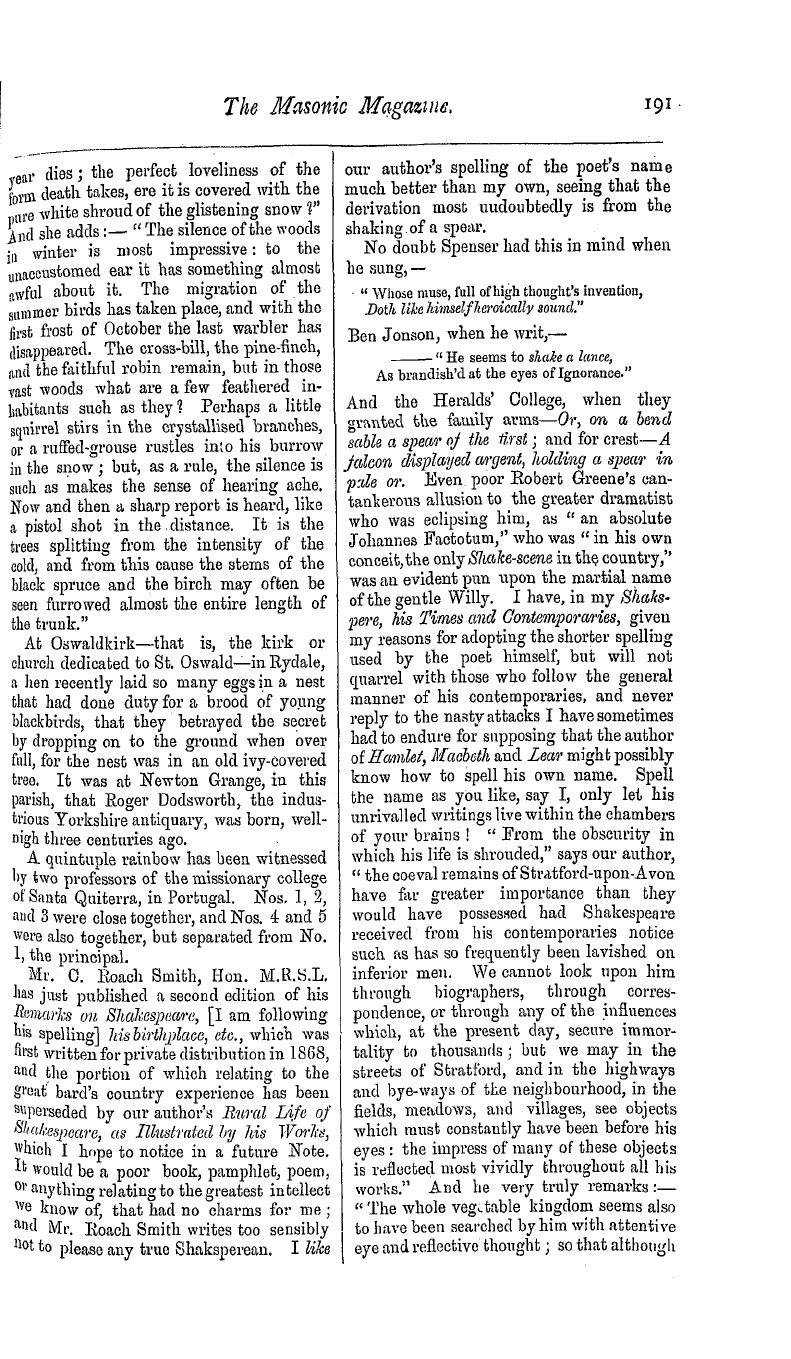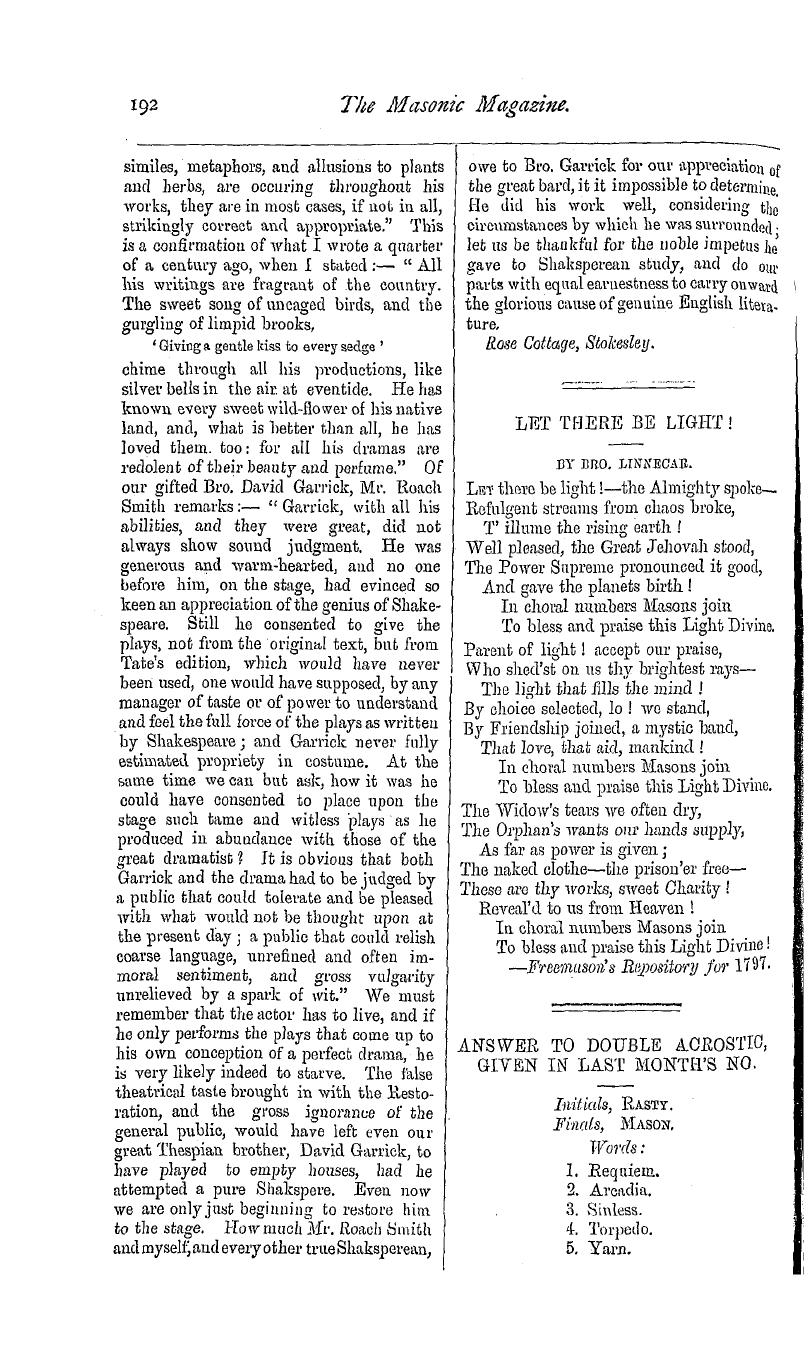-
Articles/Ads
Article THE WORK OF NATURE IN THE MONTHS. ← Page 2 of 5 →
Note: This text has been automatically extracted via Optical Character Recognition (OCR) software.
The Work Of Nature In The Months.
journey to see . We remember viewing it one Autumn afternoon , a little before sunset , from the summit of a crag , on one side of the little ravine , called the Raven's Rock , and the tree-covered slope , on the other side of the little trout stream , visible with its waterfall in the depths belowclad
, in all the lovely tints of Autumnal decay , and viewed through that shimmering atmosphere that shines so blue in the Autumn afternoon , gave us a realization , for once in our lives , of all the glories of our childhood ' s Fairy-Land . Fair reader , go and
behold Autumn there , and tell us if you will ever again sigh for the departed Summer . Whilst Autumn thus asserts the reality of the intrinsic beauty that she possesses , does she speak to us in a mournful strain , if even her tones be solemn 1 We trow
not . Does she not point us to rest after labour ; the reward of a well-spent life ; to that " hoary head which is a crown if it be found in the way of righteousness ?" And if those leaves do " fall dry and withered to the ground , " do they not speak to us of a purpose fulfilled , a
" Something attempted , Something done , That has earned a night's repose ?" And yet further , do they not lead us to think of the joyful re-awakening of such in the Spring-time beyond the grave ? Let
us welcome then the voice of Autumn , which , although it bids us think of our own " Sear and yellow leaf , " yet tells us to prepare to change the crown of hoary age for that other " crown that fadeth not
away . ' But , putting altogether aside the lessons that the Creator thus deigns to teach us by the time of the falling leaf , all created Nature , from the smallest to the greatest , benefits in some material way even by this season of decadence and decay . The
shedding of the leaves and their resolution into their component parts , is the natural process whereby the bosom of Mother Earth is continually refertilized , and it is from this very fact of nothing being lost , but even death itself affording material for
fresh life , that we may draw our most strongly enforced lesson ^ -Nature-taughtof the resurrection of our own earthly tabernacles of these mortal bodies .
But apart , again , from even this provision for a future year , as well as its lessons respecting our own future , Earth and her inhabitants may well rejoice , for this is the great season of ingathering ' of Winter store for all those denizens of
field and wood that neither emigrate nor hibernate . Time was when the "Lord of Creation " himself gladly hailed the falling shower of meat , but now , although he in his civilization has developed more convenient ways of gratifying his more fully
developed tastes , there are yet myriads of creatures to which Autumn is a gladsome time . " The fowls of the air . sow not , nor reap , nor gather into barns , yet Tour Heavenly Father feedeth them . " Witness the coralred berries to which the snowy blossoms of May have given place on every
" Hawthorn in the dale . " Who does not remember the " Haws " of our childhood , and if we forget them the birds do not . The Hawthorn—Dutch Hoeg-dorn ( Hedgethorn ) , German Hage dorn—is esteemed the best
shrub for hedges on account of its quick growth when young ( whence known in Agricultural Counties as " Quick" ) , as well as of its bearing frequent clipping . Planted alone , it often attains a good size . Its name of " Whitethorn " calls to mind
another of our boyhood ' s favourites , the " Blackthorn " or Sloe . The wood of both these shrubs is a great favourite for light walking-sticks and whipstocks . The fruit
of the Sloe is a small black plum , which , however , by reason of the beautiful bloom by which it is covered , appears of a brig ht blue colour . Its taste by no means accords with its looks , for it is frightfully acid , and so rough as to be swallowed with difficulty ; a good frosthoweverrenders it not
, , only endurable , but really pleasant eating . Amongst the rural poor , the Sloe is a most valuable neighbour for its fruit , buried in bottles underground , or packed away in jars of coarse sugar , aflords many a good pudding in the winter . In days gone by
too , even if not now , the bush has had a high commercial value , for many is the pipe of Spanish Port that has been yielded by its berries ; nor has the Teatotaller been less indebted to its branches than the most inveterate winebibber , for its leaves have
Note: This text has been automatically extracted via Optical Character Recognition (OCR) software.
The Work Of Nature In The Months.
journey to see . We remember viewing it one Autumn afternoon , a little before sunset , from the summit of a crag , on one side of the little ravine , called the Raven's Rock , and the tree-covered slope , on the other side of the little trout stream , visible with its waterfall in the depths belowclad
, in all the lovely tints of Autumnal decay , and viewed through that shimmering atmosphere that shines so blue in the Autumn afternoon , gave us a realization , for once in our lives , of all the glories of our childhood ' s Fairy-Land . Fair reader , go and
behold Autumn there , and tell us if you will ever again sigh for the departed Summer . Whilst Autumn thus asserts the reality of the intrinsic beauty that she possesses , does she speak to us in a mournful strain , if even her tones be solemn 1 We trow
not . Does she not point us to rest after labour ; the reward of a well-spent life ; to that " hoary head which is a crown if it be found in the way of righteousness ?" And if those leaves do " fall dry and withered to the ground , " do they not speak to us of a purpose fulfilled , a
" Something attempted , Something done , That has earned a night's repose ?" And yet further , do they not lead us to think of the joyful re-awakening of such in the Spring-time beyond the grave ? Let
us welcome then the voice of Autumn , which , although it bids us think of our own " Sear and yellow leaf , " yet tells us to prepare to change the crown of hoary age for that other " crown that fadeth not
away . ' But , putting altogether aside the lessons that the Creator thus deigns to teach us by the time of the falling leaf , all created Nature , from the smallest to the greatest , benefits in some material way even by this season of decadence and decay . The
shedding of the leaves and their resolution into their component parts , is the natural process whereby the bosom of Mother Earth is continually refertilized , and it is from this very fact of nothing being lost , but even death itself affording material for
fresh life , that we may draw our most strongly enforced lesson ^ -Nature-taughtof the resurrection of our own earthly tabernacles of these mortal bodies .
But apart , again , from even this provision for a future year , as well as its lessons respecting our own future , Earth and her inhabitants may well rejoice , for this is the great season of ingathering ' of Winter store for all those denizens of
field and wood that neither emigrate nor hibernate . Time was when the "Lord of Creation " himself gladly hailed the falling shower of meat , but now , although he in his civilization has developed more convenient ways of gratifying his more fully
developed tastes , there are yet myriads of creatures to which Autumn is a gladsome time . " The fowls of the air . sow not , nor reap , nor gather into barns , yet Tour Heavenly Father feedeth them . " Witness the coralred berries to which the snowy blossoms of May have given place on every
" Hawthorn in the dale . " Who does not remember the " Haws " of our childhood , and if we forget them the birds do not . The Hawthorn—Dutch Hoeg-dorn ( Hedgethorn ) , German Hage dorn—is esteemed the best
shrub for hedges on account of its quick growth when young ( whence known in Agricultural Counties as " Quick" ) , as well as of its bearing frequent clipping . Planted alone , it often attains a good size . Its name of " Whitethorn " calls to mind
another of our boyhood ' s favourites , the " Blackthorn " or Sloe . The wood of both these shrubs is a great favourite for light walking-sticks and whipstocks . The fruit
of the Sloe is a small black plum , which , however , by reason of the beautiful bloom by which it is covered , appears of a brig ht blue colour . Its taste by no means accords with its looks , for it is frightfully acid , and so rough as to be swallowed with difficulty ; a good frosthoweverrenders it not
, , only endurable , but really pleasant eating . Amongst the rural poor , the Sloe is a most valuable neighbour for its fruit , buried in bottles underground , or packed away in jars of coarse sugar , aflords many a good pudding in the winter . In days gone by
too , even if not now , the bush has had a high commercial value , for many is the pipe of Spanish Port that has been yielded by its berries ; nor has the Teatotaller been less indebted to its branches than the most inveterate winebibber , for its leaves have
















































